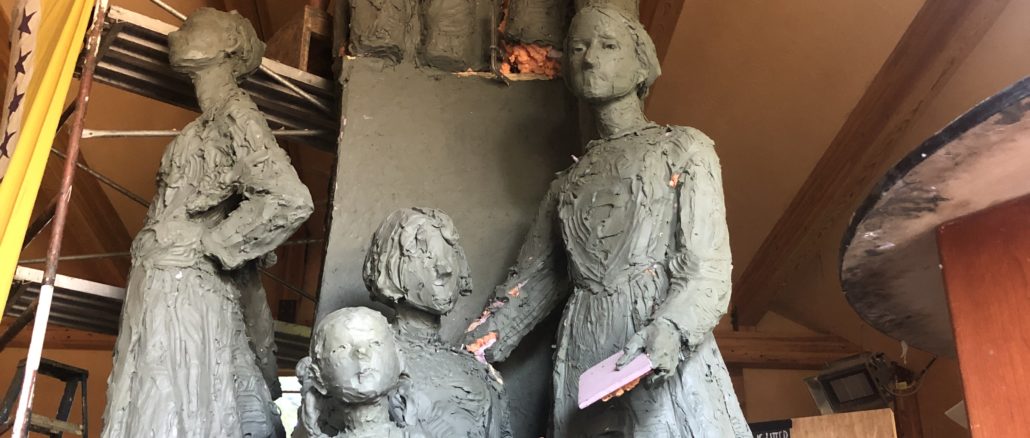
Support Northern Colorado Journalism
Show your support for North Forty News by helping us produce more content. It's a kind and simple gesture that will help us continue to bring more content to you.
BONUS - Donors get a link in their receipt to sign up for our once-per-week instant text messaging alert. Get your e-copy of North Forty News the moment it is released!
Click to DonateBy Cherry Sokoloski
Well-known Loveland sculptor Jane DeDecker is taking her art to new heights: she’s working on a 22-foot sculpture to be placed in Washington, D.C., honoring the women’s suffrage movement. This year marks 100 years since the 19th Amendment became part of the U.S. Constitution, giving women across America the right to vote.
A bill authorizing the monument was signed by President Trump on Dec. 17, following passage by the U.S. Senate earlier in the month. “Just in the nick of time,” commented DeDecker, referring to the bill’s success in the last days of the suffrage centennial year. “It’s an important issue, and we need to finally recognize these women. It’s really astonishing what they accomplished with their voices, their pens – and few financial resources.”
Four Western states – including Colorado – were the first to give women the right to vote decades before the 19th Amendment was ratified. “That’s something to really be proud of,” DeDecker stated, and she considers her suffrage monument to be a gift from the Western United States.
To have a monument placed in Washington, D.C., applicants must jump through a staggering 24 hoops – an intimidating process entailing several trips to the capital. In fact, when DeDecker and her team appeared before the National Capital Memorial Advisory Commission in 2019, one commission member said they were “crazy” for attempting this feat. “You are on the road to success,” he said, “but it’s a very long road.”
Nonetheless, DeDecker said, commission members were very “keen and enthused” about her concept for the monument, and they approved the project. With Congressional approval now accomplished, the next step is site selection for the monument.
The Design
In her concept for the monument, the artist chose six individuals to represent the women’s suffrage movement. On the bottom tier of the piece, representing the first generation of suffragists, are Elizabeth Cady Stanton and Susan B. Anthony, often considered the mothers of the suffrage movement; and Sojourner Truth, a former slave who was a powerful public speaker for women’s rights and the abolition of slavery. One of Stanton’s children, Harriot Stanton Blatch, is depicted as a child on the bottom tier. She would later carry on her mother’s work.
Standing on these giants’ shoulders are the later generation of suffragists, represented in the sculpture by Alice Paul and Ida B. Wells-Barnett. Paul reenergized the early 20th-century movement, adopting a more militant strategy, including parades, White House pickets, and hunger strikes. Wells-Barnett, a journalist and anti-lynching crusader, founded the first African-American women’s suffrage organization. In working for the vote, black women had to fight politicians and racial prejudice within the movement since many Southern women would not march alongside sisters of color.
Of the six women, only Blatch, Paul, and Wells-Barnett lived to see the 19th Amendment signed into law.
The monument’s title, “Every Word We Utter,” was inspired by a letter from Stanton to a friend, referring to how the movement spread. The ripples at the base of the piece depict the movement’s cumulative energy, plus the ongoing struggle for women’s equality. “The ripples continue, and we are part of that effort,” said DeDecker. “We’re still chipping away.”
The first generation of suffragists aspired to vote but couldn’t, she noted. “They dedicated their whole lives to suffrage – and women’s rights in general – but never achieved their goals. It’s heartbreaking.”
The team working on the project includes DeDecker’s husband, Kyle Dallabetta, and Jody Shadduck-McNally, president of the not-for-profit board, Every Word We Utter. Shadduck-McNally has played a large role in navigating D.C.’s political quagmire, helping to set up important meetings in the capital. “It’s a pretty arduous process,” she commented.
On one trip to D.C., the three knocked on the doors of 97 U.S. senators to make their case. The organization is also raising funds to cover the sculpture’s cost, which could be $2.5 million or more.
DeDecker summed up the long, hard road this way: “We’re getting a monument for women in D.C., and that’s worth all the effort.”
Jane DeDecker has spent most of her life in Loveland, CO. She has been sculpting for 35 years and currently has 150 public sculptures in 35 states, including about 13 in Loveland, plus many pieces in private collections. To learn more about the women’s suffrage monument or donate to the project, go to www.everywordweutter.com.
